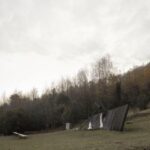Ester’s Grotto Memorial, designed by Alarcón+Fuhrhop+Montalbetti architects, stands as a unique testament to the intersection of memory, time, and place in Liucura, Chile. Unlike conventional religious structures, this memorial transcends physical boundaries to embrace the immaterial aspects of collective memory and cultural heritage.

Constructing Grief: A Conceptual Approach
Beyond the tangible aspects of architecture lie countless intangible references inherited through time and memory. The architects recognize the need to relinquish preconceived notions and prejudices associated with built environments. Instead, they embrace a process of resignification, where mourning becomes a means of constructing grief.

Material Exploration and Constructive Perspective
Rather than adhering to conventional norms, the architects opted for a constructive perspective that challenges traditional building methods. Working with concrete, an unusual choice for the area, provided an opportunity for material exploration and freedom in design. Fifty prefabricated concrete pieces, resembling menhirs, were erected on-site, each bearing unique textures and imperfections that blur the boundaries between individuality and collective memory.


Creating Spatial Dynamics
The memorial’s design creates a dialogue between two distinct spaces: one facing the valley for liturgical activities and another nestled against the hillside, secluded and marked by a commemorative tree. These spaces are interconnected yet separated by a wall formed from the repetition of concrete pieces, symbolizing the tension between stability and disruption.

Embracing the Temporal Aspect
Central to the project is the recognition of time as a crucial component. The memorial’s appearance will evolve over time, reflecting the changing landscape of memory and interpretation. As memories fade and structures weather, the true essence of the memorial will be revealed, prompting discussions about its significance and appreciation.
Ester’s Grotto Memorial transcends conventional notions of worship architecture, embracing a conceptual framework that intertwines memory, materiality, and spatial dynamics. As a testament to the ever-evolving nature of collective memory, this memorial invites contemplation and reflection on the intricate relationship between architecture and the passage of time.


















Leave a Reply